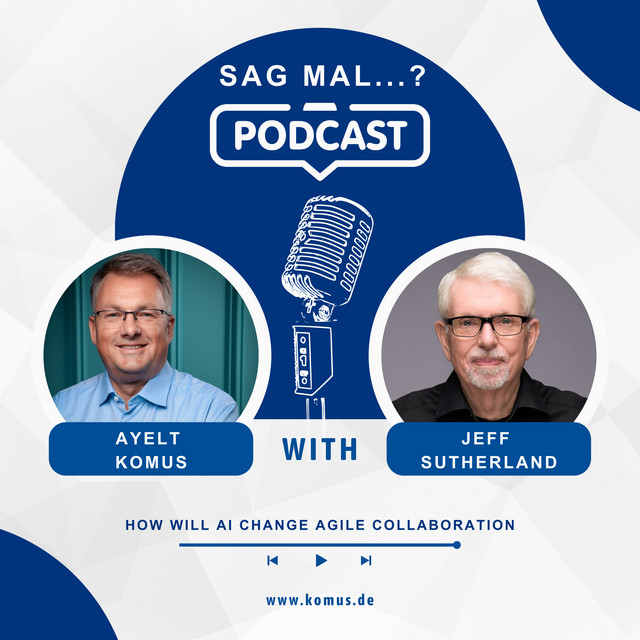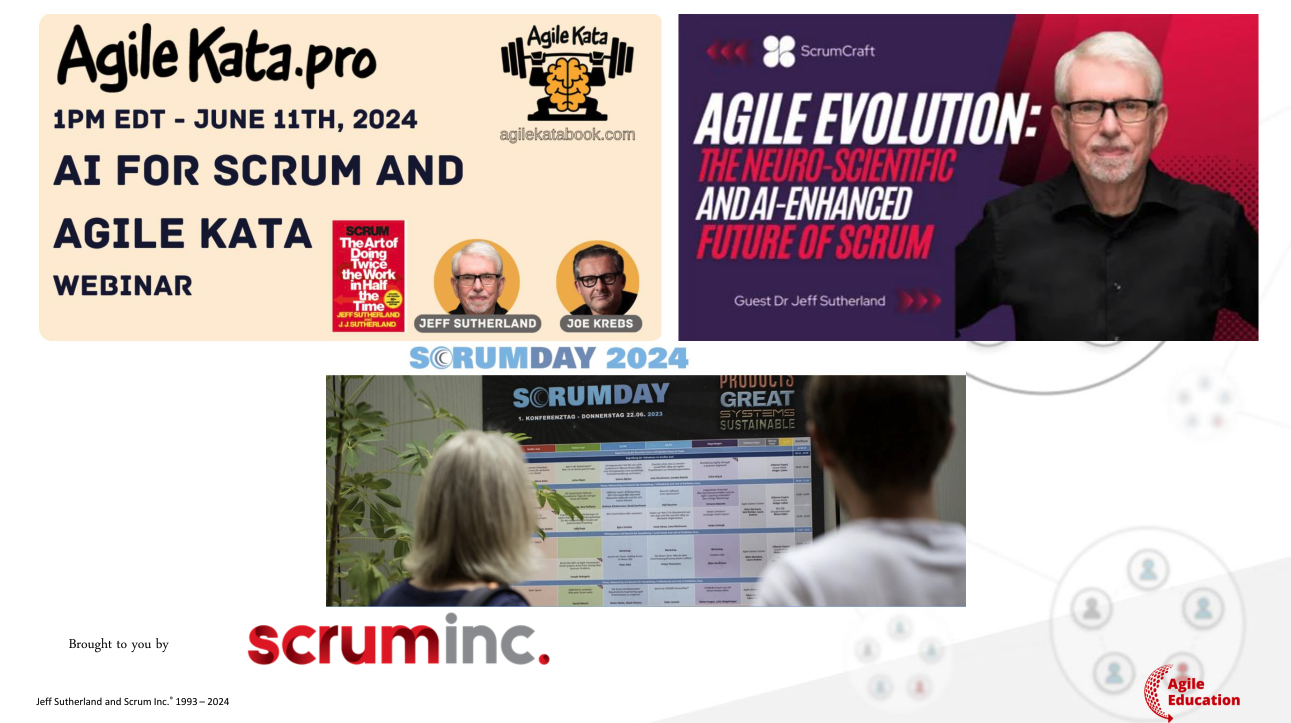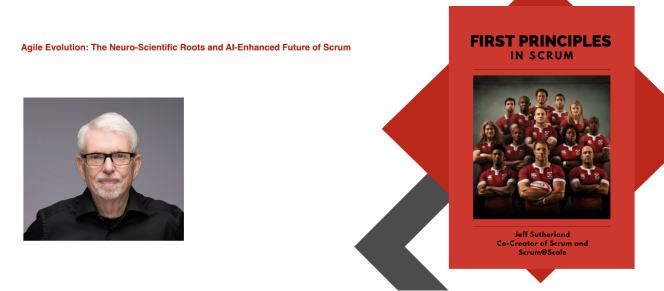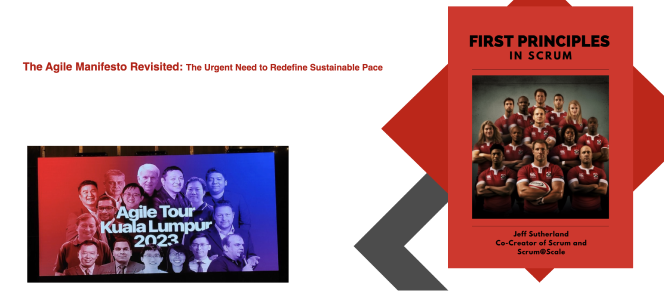AI in Scrum: Podcast Insights from Dr. Jeff Sutherland In a recent podcast episode, Dr. Jeff Sutherland delved into the transformative impact of artificial intelligence (AI) on Scrum practices. This episode is a must-listen for anyone interested in the future of agile methodologies and how AI can elevate team performance. Embracing AI in Scrum Dr. Sutherland highlights the critical role AI plays in enhancing Scrum processes. By automating routine tasks and providing advanced analytics, AI allows Scrum teams to focus on creativity and problem-solving. Here are some key points from the podcast: Key Takeaways Practical Applications The integration of AI into Scrum is not just theoretical; it’s already being applied successfully in various industries. Companies are seeing substantial improvements in efficiency and output, demonstrating the tangible benefits of merging AI with agile practices. Listen to the Podcast For a deeper dive into these insights, listen to the full podcast episode here. Book a Consultation with Dr. Jeff Sutherland Dr. Sutherland offers personalized consultations to help you integrate AI into your workflows and maximize your team’s potential. Book Your Consultation Now Conclusion Dr. Jeff Sutherland’s podcast provides valuable insights into the future of Scrum with AI. By embracing these technologies, teams can significantly enhance their performance and stay ahead in an ever-evolving landscape. Don’t miss out on these groundbreaking strategies—tune in to the podcast and explore how AI can transform your agile practices today. Stay tuned for more updates and insights from Dr. Sutherland and the JVS Management team as we continue to push the boundaries of what’s possible with Scrum.
Category Archives: Uncategorized
Renaissance Scrum Master: Brunelleschi’s Influence
Renaissance Scrum Master: Brunelleschi’s Influence We at JVS Management are thrilled to introduce an illuminating addition to Jeff Sutherland’s First Principles in Scrum. Our latest chapter delves into the story of Filippo Brunelleschi, the architect of the Florence Cathedral’s dome, showcasing his pioneering approach that eerily echoes modern Scrum practices. Brunelleschi: The Original Scrum Master Insights from the Renaissance to the Agile Era Lessons from History for Today’s Scrum Masters Brunelleschi’s work offers rich lessons for today’s project managers and Scrum practitioners. His ability to lead without imposing strict controls, but rather inspiring and coordinating skilled artisans, underscores the Scrum values of courage, focus, commitment, and respect. Why This Matters Now The story of Brunelleschi is not just historical trivia but a powerful analogy for modern Agile practices. It reflects the potential of human ingenuity and teamwork under a shared vision, qualities as essential today as they were in the Renaissance. This chapter encourages modern Scrum practitioners to draw strength from these historical roots to enhance their own methodologies and team dynamics. Connect with the Past to Innovate the Future Join us on a journey back to the Renaissance to understand the foundational aspects of leadership and project management that predate Scrum by centuries but are strikingly relevant today. For those looking to deepen their understanding of Scrum’s versatility and historical depth, the full story awaits in the latest edition of Jeff Sutherland’s First Principles in Scrum. As an added bonus, this chapter includes a fascinating treasure in its reference section: Alberto Monciatti’s seminal paper, “Filippo Brunelleschi’s Dome, the masterpiece of an ‘Agile’ man of the Renaissance.” This insightful paper delves deeper into the agile methodologies employed by Brunelleschi, offering readers an enriched perspective on the historical and technical mastery behind the Renaissance’s greatest architectural achievements. It’s a perfect resource for those who wish to explore the roots of agile principles beyond the contemporary framework. Embrace the lessons of the past to spur innovation in your projects. Discover more about how historical insights can transform modern practices on our JVS Management Blog.
First Principles in Scrum and AI: Insights from Dr. Jeff Sutherland
First Principles in Scrum and AI: Insights from Dr. Jeff Sutherland As the agile world continues to evolve, it’s essential to revisit the foundational principles that make Scrum such a powerful framework. Dr. Jeff Sutherland, co-creator of Scrum and a thought leader in agile methodologies, offers deep insights into how first principles and artificial intelligence (AI) can transform Scrum practices. This blog post distills key concepts from his recent and upcoming presentations, providing valuable takeaways for Scrum practitioners. The Foundation: First Principles Thinking Dr. Sutherland emphasizes the importance of first principles thinking, a method famously used by Elon Musk to drive innovation at Tesla. This approach involves breaking down complex problems into their most fundamental elements and rebuilding solutions from the ground up. For Scrum teams, this means understanding the core principles that underpin agile methodologies and applying them to enhance performance and productivity. The TEHS Scrum Framework: Twice the Energy, Half the Stress One of the standout concepts introduced by Dr. Sutherland is the TEHS (Twice the Energy, Half the Stress) Scrum Framework. This innovative model integrates biophysical principles with Scrum practices to boost energy levels and reduce stress, ultimately doubling productivity. The framework leverages tools like Firstbeat analytics, used by Olympic teams, to monitor and optimize individual and team performance. Integrating AI into Scrum The integration of AI into Scrum processes is a game-changer. Dr. Sutherland illustrates how AI can automate and enhance various aspects of Scrum, from sprint planning to backlog management. For instance, AI tools can help select and refine user stories, estimate tasks, and even create sprint goals. By reducing the manual overhead, AI enables teams to focus more on creative problem-solving and delivering high-value work. Practical Applications and Real-World Impact Dr. Sutherland’s research, backed by Tesla Investment Holdings LLC, explores the practical applications of these principles. Teams that adopt first principles thinking and AI tools can achieve significant improvements in efficiency and output. For example, companies like Microsoft have already leveraged AI to enhance productivity, leading to substantial workforce transformations. Recap of Recent Events Dr. Sutherland recently delivered these insights at several key events: You can access the presentation for these events here. These events delve deeper into the intersection of first principles, AI, and Scrum, offering participants actionable strategies to implement in their teams. Book a Consultation with Dr. Jeff Sutherland For those looking to further explore these concepts and apply them to their specific contexts, Dr. Sutherland offers consultations. Whether you’re curious about integrating AI into your Scrum practices or need guidance on adopting first principles thinking, a one-on-one session with Dr. Sutherland can provide the personalized insights you need. Book Your Consultation Now Embracing first principles and AI in Scrum is not just about keeping up with trends—it’s about fundamentally transforming how teams operate and deliver value. Dr. Jeff Sutherland’s pioneering work provides a roadmap for teams looking to navigate the complexities of modern project management and emerge more resilient and productive. Stay tuned for more updates and insights from Dr. Sutherland and the JVS Management team as we continue to push the boundaries of what’s possible with Scrum. For those unfamiliar with the nuances of Scrum, it’s advised to read “Scrum: The Art of Doing Twice the Work in Half the Time” by Jeff and JJ Sutherland. And for those seeking deeper insights, consider exploring “First Principles in Scrum.”
Unlocking Team Dynamics: Discover the Power of Self-Organization in Scrum
Unlocking Team Dynamics: Discover the Power of Self-Organization in Scrum In today’s fast-paced business world, the traditional command-and-control management structures are rapidly giving way to more flexible and dynamic approaches. One such groundbreaking method is the concept of self-organization in Scrum, a core theme explored in the latest chapter of Dr. Jeff Sutherland’s updated book, First Principles in Scrum. This blog dives into the essence of self-organization and how it can revolutionize your product development strategies. For those stuck in old style project management if offers a path to seeing all projects as sets of backlog for building continuously supported and enhanced user experiences. What is Self-Organization? First Principles in Scrum research shows that in the design space of all possible teams and all possible products, self-organization arises spontaneously in a sea of chaos where most things do not work, and even if they do work it is often a constant struggle to overcome the forces of entropy which causes all systems to decay. Self-organization is therefore not something you do but a space that you discover where teams are hyperproductive and products and services are awesome. The fastest way to discover regions of spontaneous self-organizations are patterns, as articulated in “The Scrum Book: The Spirit of the Game.” In the context of Scrum, self-organization refers to the ability of teams to spontaneously organize and adapt without external direction. This concept empowers team members to take initiative, make decisions swiftly, and drive their projects forward efficiently. However, the concept was so widely abused by the Agile community where 58% of teams are late, over budget, with unhappy customers that the word “self-organization” was removed from the Scrum Guide in 2020 and replaced with “self-management.” For this reason, First Principles in Scrum goes back to fundamental findings in physics, particularly from Wolfram’s Physics Project where massive computer simulations of the universe finally give us a deep understand of entropy (the Second Law of Thermodynamics), how self-organizing patterns arise spontaneously in nature, and, in a future chapter, how patterns are like bread crumbs in a forest leading teams to a space of spontaneously arising hyperproductivity. Key Highlights from the Chapter: Teasers from the Chapter: Why This Matters: Embracing self-organization can not only streamline product delivery but also enhance job satisfaction among team members. Dr. Sutherland’s insights provide a compelling case for rethinking how teams are structured and managed in today’s digital age. Interested in transforming your team’s dynamics and achieving higher productivity? Discover the full potential of self-organization in Scrum by reading Dr. Jeff Sutherland’s latest insights. Grab your copy of the updated book on Leanpub today to delve deeper into this transformative approach. The journey towards mastering self-organization in Scrum could be the key to unlocking unprecedented levels of performance and innovation within your team. Don’t miss out on the opportunity to turn your team into a high-performing powerhouse. Read the latest chapter to start your transformation. For those unfamiliar with the nuances of Scrum, it’s advised to read “Scrum: The Art of Doing Twice the Work in Half the Time” by Jeff and JJ Sutherland. And for those seeking deeper insights, consider exploring “First Principles in Scrum“.
Estimating Sprint Planning with AI: Enhancing Agile Practices
Estimating Sprint Planning with AI: Enhancing Agile Practices In the dynamic realm of Agile, effective sprint planning is crucial for delivering high-quality products efficiently. Integrating Artificial Intelligence (AI) into sprint planning can revolutionize estimation accuracy, enhancing the Scrum framework’s adaptability and productivity. This blog post explores the foundational elements of Scrum, the role of sprint planning, and how AI can optimize this process while maintaining the core principles of team autonomy and empirical process control. Understanding Scrum: The 3-5-3 Framework Scrum, a robust framework for managing and completing complex projects, operates on a 3-5-3 structure: These components create an empirical process, enabling teams to inspect and adapt their practices continuously. The Essentials of Sprint Planning Sprint Planning is a critical event in Scrum, where the team collaborates to define what can be delivered in the upcoming sprint and how that work will be achieved. This involves: Effective sprint planning ensures alignment, focus, and a shared understanding of the work ahead. The Role of AI in Sprint Planning Integrating AI into sprint planning can significantly enhance estimation accuracy and resource allocation while respecting Scrum’s principles. Here’s how AI can transform sprint planning: Implementing AI-Enhanced Sprint Planning To effectively integrate AI into sprint planning, teams should consider the following steps: Conclusion Incorporating AI into sprint planning offers a strategic advantage, enabling more accurate estimations, better resource management, and proactive risk mitigation. By embracing AI as a supportive tool, Agile teams can enhance their productivity and adapt more swiftly to changing project dynamics, ultimately delivering higher value to customers. The synergy between humans, AI, and the Scrum framework can drive remarkable improvements in performance and innovation. Stay ahead in the Agile landscape by integrating AI into your sprint planning process, ensuring your team is equipped to deliver twice the work in half the time. For those unfamiliar with the nuances of Scrum, it’s advised to read “Scrum: The Art of Doing Twice the Work in Half the Time” by Jeff and JJ Sutherland. And for those seeking deeper insights, consider exploring “First Principles in Scrum.”
AI Scrum Planning: Streamline Your Sprints
AI Scrum Planning: Streamline Your Sprints In the fast-paced world of project management, Scrum has established itself as a transformative framework for facilitating agility and efficiency. At JVS Management, integrating Artificial Intelligence (AI) into AI Scrum Planning is taking efficiency to unprecedented levels. We’ve harnessed the power of AI to enhance decision-making, optimize resource allocation, and refine estimation processes, drastically reducing our sprint estimation time from 45 minutes to a mere minute. Training AI for Scrum Excellence The foundation of our approach begins with the meticulous training of AI tools like ChatGPT, grounded in seminal Scrum principles as outlined in Jeff Sutherland’s “Scrum: The Art of Doing Twice the Work in Half the Time”. This preparatory step ensures that our AI models are well-versed in Scrum methodologies, enabling them to provide valuable insights and predictions. Data Analysis for Prioritization Utilizing AI algorithms, we analyze an array of data sources including historical project data, user feedback, market trends, and business priorities. This comprehensive analysis aids our product owners in effectively prioritizing backlog items. For instance, the AI examines data from the last six sprints to inform story point estimations for upcoming tasks, streamlining the prioritization process. AI-Powered Estimation and Forecasting AI-powered tools are employed to scrutinize historical data on team velocity and task complexity, among other factors, to generate accurate sprint forecasts. By training ChatGPT with data from previous sprints, the tool is capable of providing estimated story points for new sprint tasks within an astonishingly short time frame. Intelligent Resource Allocation Through AI algorithms, tasks are allocated to team members based on their skills, availability, and workload capacity. This not only ensures a balanced distribution of work but also enhances overall team performance and project delivery. Dependency Analysis with AI Our teams utilize AI-powered tools for a thorough dependency analysis, which aids in identifying and visualizing dependencies between backlog items. This step is critical for planning and managing interdependent tasks effectively, ensuring a smooth workflow throughout the sprint. Proactive Risk Management AI also plays a crucial role in identifying potential risks and issues early in the planning process. By evaluating AI-generated estimates against team capacity and historical performance, we can anticipate and address potential bottlenecks or constraints before they impact the sprint. Scenario Planning for Flexibility AI-driven simulation tools allow us to generate various planning scenarios based on different assumptions and constraints. This capability enables our teams to explore alternative planning strategies and make informed decisions that align with project goals and resources. Embracing Continuous Improvement Lastly, AI provides ongoing insights and recommendations for process improvements based on data analysis and performance metrics. This not only helps in refining our planning practices but also ensures that our methodologies evolve in response to changing project dynamics. Integrating AI into Scrum planning has significantly enhanced our capabilities at JVS Management, providing us with data-driven insights, automating repetitive tasks, and facilitating more accurate forecasting and decision-making. By leveraging advanced AI technologies, our teams have been able to streamline their planning processes, improve collaboration, and deliver higher-quality products more efficiently. This AI-driven approach to Scrum is not just about maintaining pace with technological advancements but about setting new standards in project management efficiency. Explore more about how AI can revolutionize your project management practices by contact us directly though JVS Management contact form. Join us in transforming the landscape of Scrum planning and project delivery through innovative technology solutions.
Unveiling the Future of Agility: Neuroscience and AI Enhance Scrum Practices
Unveiling the Future of Agility: Neuroscience and AI Enhance Scrum Practices In the rapidly evolving world of Agile development, the journey from a Swiss meetup to an upcoming Australian conference showcases how Dr. Jeff Sutherland’s pioneering work continues to shape the future of business agility across the globe. As the co-creator of Scrum and a signatory of the Agile Manifesto, Dr. Sutherland bridges agile methodologies with the latest in neuroscience and artificial intelligence, offering organizations a forward-thinking framework to thrive amidst change. A Foundation in Universal Science During his Swiss presentation, Dr. Sutherland unveiled the deep-rooted connection between the Scrum framework and the immutable laws governing our universe—from physics to biology. His insights emphasized Scrum’s broad applicability, extending far beyond traditional product development. At the heart of his upcoming Australian meetup, Dr. Sutherland will further explore how Scrum’s agile practices mirror the natural world’s principles, such as those found in Wolfram’s Physics Project and Friston’s Free Energy Principle. This integration positions Scrum as an innate system for managing complex adaptive environments, reflecting the empirical processes intrinsic to both Scrum and evolutionary dynamics. Empowering Agile Teams with AI A central theme of Dr. Sutherland’s discourse, both in Switzerland and anticipated in Australia, is the transformative role of AI within Agile teams. Contrary to concerns about AI overshadowing human capabilities, Dr. Sutherland illustrates AI’s potential to enhance human creativity and collaboration. Through examples and theoretical exploration, he champions AI as a catalyst for empowering teams, driving innovation, and elevating productivity within the Scrum framework. Charting a Course to Hyper-Productivity Dr. Sutherland’s TEHS Scrum Framework—aiming for “Twice the Energy with Half the Stress”—showcases the application of physics and neuroscience principles to foster empowered, innovative teams. Success stories from industry leaders like Rocket Mortgage and John Deere highlight the potential of agile methodologies enriched by scientific understanding and AI advancements. These narratives underscore a shift towards more adaptive, resilient, and high-performing organizational cultures. Global Implications and Opportunities The convergence of neuroscience and AI with Scrum practices heralds unprecedented opportunities for innovation and growth on a global scale. As Dr. Sutherland prepares to share his knowledge in Australia, following his Swiss presentation, organizations worldwide are encouraged to explore these principles and their applicability to their operations. The promise of an enhanced Scrum framework, underpinned by the latest scientific and technological advances, points the way to unparalleled agility and productivity. Join the Global Agile Revolution As we navigate the digital age’s complexities, Dr. Sutherland’s insights offer a beacon for organizations worldwide. By embracing Scrum’s neuro-scientific foundations and integrating AI, businesses can unlock new levels of performance and innovation. As the agile revolution unfolds from Switzerland to Australia and beyond, we’re invited to redefine collaboration and work. Dive into the transformative concepts discussed by Dr. Sutherland, which have resonated from Switzerland and will soon inspire audiences in Australia. Begin a journey of discovery and empowerment, revolutionizing your agility and productivity approach. Access Dr. Jeff Sutherland’s Presentation Slides Here. For those unfamiliar with the nuances of Scrum, it’s advised to read “Scrum: The Art of Doing Twice the Work in Half the Time” by Jeff and JJ Sutherland. And for those seeking deeper insights, consider exploring “First Principles in Scrum.”
Teams That Finish Early Accelerate Faster: Maximizing Early Sprint Completion Strategies for Agile Teams
Teams That Finish Early Accelerate Faster: Maximizing Early Sprint Completion Strategies for Agile Teams In a landscape where unpredictability is the only constant, Karl Friston’s Free Energy Principle sheds light on the importance of minimizing surprise to optimize brain function. This principle, grounded in Bayesian brain theories, posits that the brain is constantly making predictions about the world and minimizing its free energy—or, put simply, the difference between what it expects and what it encounters. When applied to Agile development teams, this model emphasizes the cost of unexpected deviations from the plan, such as the rework and explanation required when things don’t go as expected. Conversely, when teams finish early, avoiding the need for replanning and the associated “Bayesian Surprise,” they not only save resources but also foster a more positive and productive environment. This not only boosts morale but opens the door to innovation and continuous improvement by allowing teams to pull new work into the sprint, experiment with new ideas, or refine existing processes without the pressure of looming deadlines. In the dynamic world of Agile development, a Scrum team finishing their work ahead of schedule within a sprint presents not just a moment of early triumph but a golden opportunity to further amplify value and efficiency. For teams operating under the Scrum framework, this scenario opens up a plethora of avenues to enhance their workflow, product quality, and team dynamics. Here’s a comprehensive look at the strategic steps a team can undertake when they find themselves ahead of the game. 1. Sprint Backlog Review The immediate step is to revisit the Sprint Backlog. Identifying any additional work that can be advanced ensures the momentum is maintained. It’s crucial, however, to ensure that these items meet the “Definition of Ready” criterion to prevent diving into ill-defined tasks. 2. Backlog Refinement and Planning An early finish provides the perfect timing for backlog refinement. This phase is critical for streamlining future sprints, whether it’s through breaking down larger items, estimating upcoming stories, or realigning priorities in collaboration with the Product Owner. 3. Enhancing Code Quality and System Health When a Scrum team finds themselves ahead of schedule, it presents an opportune moment to focus on enhancing the overall health of the codebase. This period can be used to revisit and improve aspects of the project that have been previously sidelined, such as refining code, optimizing system performance, or updating and expanding documentation. Prioritizing these improvements not only bolsters the system’s maintainability but also lays a stronger foundation for future development efforts. This proactive approach to system enhancement aligns with Agile principles of continuous improvement and maintaining high standards of quality. 4. Innovation Time Allocating time for innovation or exploration of new technologies and processes can sow the seeds for future project efficiencies. Conducting spikes to investigate new methodologies or tools can provide valuable insights and potential competitive advantages. 5. Knowledge Sharing Initiatives Utilizing this time for knowledge sharing can significantly boost the team’s collective expertise. Organizing workshops, code reviews, or documenting best practices not only fosters skill development but also enhances team synergy. 6. Process and Team Strengthening An additional retrospective or team-building session can be invaluable for fine-tuning Agile practices and bolstering team morale. These sessions are instrumental in identifying and removing impediments to smoother sprint cycles. 7. Cross-Team Collaboration Offering a helping hand to other teams lagging behind reinforces a culture of collaboration and accelerates collective project milestones, showcasing the spirit of teamwork and mutual success. 8. Future Sprint Preparations Beginning preparations for upcoming sprints ahead of time sets a solid foundation for continued success. This could involve environment setups, preliminary research, or essential documentation, ensuring a seamless transition into the next cycle. 9. Enhanced Customer Collaboration Early completion allows for increased stakeholder engagement. Demonstrating completed work for early feedback or delving deeper into potential backlog items can enrich the product’s alignment with stakeholder expectations. 10. Personal Development Focus Encouraging team members to engage in personal development during this time can be profoundly beneficial. Whether it’s learning new software tools, absorbing industry insights, or pursuing certifications, investing in personal growth contributes to the team’s and the organization’s resilience and adaptability. Seizing the Opportunity For Agile teams, finishing sprint tasks early is not just an achievement; it’s a launching pad for continuous improvement and innovation. By involving the Product Owner and possibly consulting the Scrum Sage:Zen Edition GPT in these strategic decisions, teams ensure their efforts are in perfect harmony with the overarching product strategy and organizational objectives. In conclusion, early sprint completion is an opportunity that Agile teams should leverage to add value, fortify their capabilities, and prepare for future challenges. It underscores the essence of Agile and Scrum principles: adaptability, continuous improvement, and a relentless focus on delivering exceptional value. By embracing the lessons from Friston’s Free Energy Principle, Agile teams can navigate the uncertainties of development with greater foresight and flexibility, turning early sprint completions into strategic advantages for innovation, quality enhancement, and team growth. This alignment not only propels teams toward accelerated development cycles but also fosters an environment where continuous learning and improvement are the norms, thereby ensuring that Agile teams not only meet but exceed their goals with efficiency and creativity. For those unfamiliar with the nuances of Scrum, it’s advised to read “Scrum: The Art of Doing Twice the Work in Half the Time” by Jeff and JJ Sutherland. And for those seeking deeper insights, consider exploring “First Principles in Scrum.”
Unveiling the Synergy of Agile and Philosophy: Scrum Sage by Jeff Sutherland – A Paradigm Shift in Project Management
Unveiling the Synergy of Agile and Philosophy: Scrum Sage by Jeff Sutherland – A Paradigm Shift in Project Management In the ever-evolving realm of project management, the quest for innovation is relentless. Scrum Sage by Jeff Sutherland, brought to you by JVS Management, stands at this frontier. This isn’t just another methodology – it’s a philosophical revolution in team dynamics and project execution, blending the wisdom of Agile with profound insights from the realms of physics and Eastern philosophy. Exploring the Depths of Scrum Sage by Jeff Sutherland Developed by Jeff Sutherland, a luminary in the Agile world, Scrum Sage is an enlightened iteration of Agile methodology. This comprehensive approach transcends traditional productivity metrics, advocating for a deeper, more harmonious interplay between team members. It’s a mindset revolution, emphasizing continuous growth, adaptability, and an unwavering commitment to delivering excellence. The Multifaceted Benefits of Scrum Sage – Elevated Productivity: Scrum Sage transcends conventional project management by breaking complex challenges into manageable ‘sprints.’ This methodology accelerates project completion while upholding quality, mirroring the natural flow of evolution and adaptation as suggested by the Second Law of Thermodynamics. – Holistic Team Collaboration: At its core, Scrum Sage fosters a culture where every voice matters, catalyzing innovative solutions and a seamless workflow, much like the interconnectedness celebrated in Eastern philosophies. – Adaptability and Relevance: In a world where change is constant, Scrum Sage equips teams with the agility to pivot swiftly, ensuring that solutions remain relevant and impactful. – Pursuit of Perfection: With its roots in continuous learning and self-improvement, akin to the principles of the Buddhist Eightfold Path, Scrum Sage encourages teams to refine and elevate their work practices perpetually. Why Scrum Sage Stands Apart Choosing Scrum Sage means embracing a holistic path to excellence. It is the ideal choice for organizations aiming to: – Accelerate project delivery without sacrificing quality. – Cultivate deep, meaningful collaboration and communication within teams. – Navigate and adapt to an ever-changing business landscape. – Embed a culture of relentless improvement and innovative thinking. Embracing the Future with Scrum Sage Scrum Sage by Jeff Sutherland is more than a methodology; it’s a transformative journey towards peak project management efficiency. It empowers teams, refines processes, and produces tangible, impactful results. At JVS Management, we’re not just advocates of innovation; we embody it, and Scrum Sage is our beacon. Adopt Scrum Sage to redefine your approach to project management and witness your team soar to unprecedented heights of proficiency. Experience the Scrum Sage Revolution Discover how Scrum Sage can revolutionize your approach to project management. Visit JVS Management and embark on a journey towards transformative project excellence with Scrum Sage.
Rediscovering the Core of Agility: Dr. Jeff Sutherland’s Insightful Keynote on “The Agile Manifesto Revisited”
Rediscovering the Core of Agility: Dr. Jeff Sutherland’s Insightful Keynote on “The Agile Manifesto Revisited” In an era marked by rapid technological evolution and market disruptions, the Agile community recently gathered at the Agile Tour Kuala Lumpur 2023 to revisit a cornerstone of modern software development – the Agile Manifesto. Dr. Jeff Sutherland, an influential figure in the Scrum community and co-creator of Scrum and Scrum@Scale, delivered a keynote that not only provoked thought but called for urgent action. Reexamining a Foundational Text After Two Decades The Agile Manifesto, drafted 22 years ago by 17 software development visionaries, promised a radical shift in how we conceive and execute project management and product development. Dr. Sutherland, revisiting this seminal document, shed light on a startling statistic: despite the widespread adoption of Agile methodologies, more than half of Agile teams and transformations fall short of their goals. The crux of the issue? A deviation from the fundamental principles that are the very heartbeat of Agile and Scrum. The Shift from Agile Principles to Practices On the snowy slopes of Snowbird, Utah, the pioneers of Agile laid down values and principles that were meant to inspire and guide. Dr. Sutherland reminded us that somewhere along the way, the fervor to adopt Agile practices overshadowed the need to comprehend and implement its core values. This oversight necessitated a re-envisioning of Scrum training and the substantial update to the Scrum Guide in recent years. Embracing Uncertainty in a Computable Universe The keynote drew parallels between the unpredictability of software projects and Stephen Wolfram’s Physics Project, which highlights the inherent unpredictability of the universe. Dr. Sutherland emphasized that recognizing and embracing this uncertainty is at the heart of Agile implementation via Scrum, and it’s what makes working from First Principles not merely an intellectual exercise but a practical necessity for success. Sustainable Pace: The Need for Reinterpretation One of the most compelling moments of Dr. Sutherland’s address was his call to reclaim the term “Sustainable Pace.” Once meant to signify enduring high performance, it has been misconstrued to excuse mediocrity and a lack of accountability. By redefining this concept, we pave the way for a resurgence in productivity and adaptability within complex systems. Restoring Balance with True Agile and Scrum Principles To counteract the dilution of Agile’s essence, Dr. Sutherland recommended a recommitment to the core principles of Agile and Scrum. He argued for the establishment of checks and balances that ensure terms like “Sustainable Pace” maintain their integrity and continue to drive high performance at both the team and individual levels. Metrics and adaptability are pivotal in this recalibration. Looking Forward with the Original Agile Vision Concluding his compelling keynote, Dr. Sutherland urged the Agile community to reevaluate and realign with the foundational Agile principles. It is only by returning to these roots, he contends, that we can fully unlock the transformative potential of Agile and Scrum. In a move to extend the conversation beyond the conference, Dr. Sutherland’s presentation slides from the Agile Tour Kuala Lumpur 2023 are available for a deeper dive into this critical discourse. We invite you to review them, reflect on your practices, and engage with the community on how we can all better adhere to the principles that once promised to revolutionize software development. Access Dr. Jeff Sutherland’s Keynote Presentation Slides Here. As we continue to navigate an increasingly complex world, may we all renew our commitment to the Agile way of life, not just in our methodologies but in our mindsets. Agile is more than a manifesto; it’s a continuous journey toward excellence. For those unfamiliar with the nuances of Scrum, it’s advised to read “Scrum: The Art of Doing Twice the Work in Half the Time” by Jeff and JJ Sutherland. And for those seeking deeper insights, consider exploring “First Principles in Scrum.”










